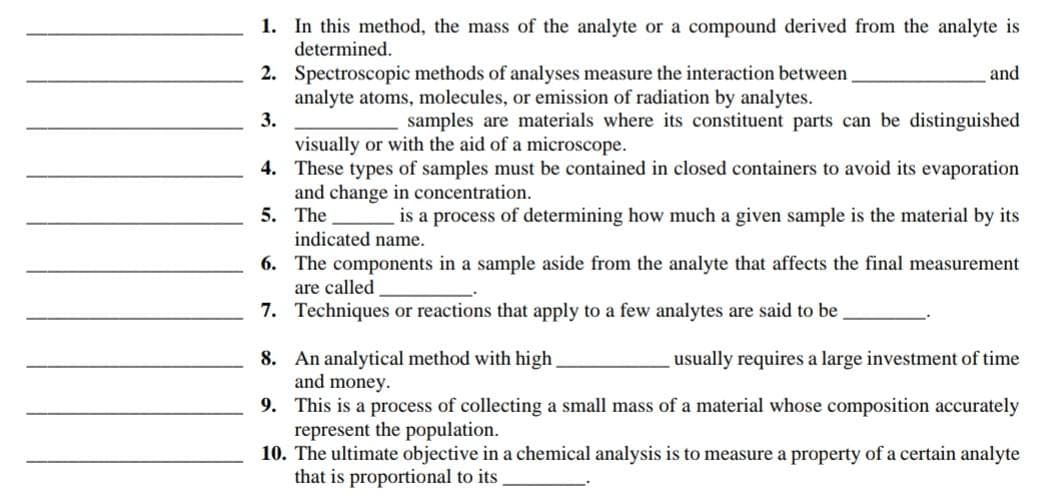1. In this method, the mass of the analyte or a compound derived from the analyte is determined. 2. Spectroscopic methods of analyses measure the interaction between analyte atoms, molecules, or emission of radiation by analytes. 3. visually or with the aid of a microscone. and samples are materials where its constituent parts can be distinguished
1. In this method, the mass of the analyte or a compound derived from the analyte is determined. 2. Spectroscopic methods of analyses measure the interaction between analyte atoms, molecules, or emission of radiation by analytes. 3. visually or with the aid of a microscone. and samples are materials where its constituent parts can be distinguished
Chemistry
10th Edition
ISBN:9781305957404
Author:Steven S. Zumdahl, Susan A. Zumdahl, Donald J. DeCoste
Publisher:Steven S. Zumdahl, Susan A. Zumdahl, Donald J. DeCoste
Chapter1: Chemical Foundations
Section: Chapter Questions
Problem 1RQ: Define and explain the differences between the following terms. a. law and theory b. theory and...
Related questions
Question

Transcribed Image Text:1. In this method, the mass of the analyte or a compound derived from the analyte is
determined.
2. Spectroscopic methods of analyses measure the interaction between,
analyte atoms, molecules, or emission of radiation by analytes.
3.
and
samples are materials where its constituent parts can be distinguished
visually or with the aid of a microscope.
4. These types of samples must be contained in closed containers to avoid its evaporation
and change in concentration.
5. The
indicated name.
is a process of determining how much a given sample is the material by its
6. The components in a sample aside from the analyte that affects the final measurement
are called
7. Techniques or reactions that apply to a few analytes are said to be
usually requires a large investment of time
8. An analytical method with high
and money.
9. This is a process of collecting a small mass of a material whose composition accurately
represent the population.
10. The ultimate objective in a chemical analysis is to measure a property of a certain analyte
that is proportional to its
Expert Solution
This question has been solved!
Explore an expertly crafted, step-by-step solution for a thorough understanding of key concepts.
Step by step
Solved in 2 steps

Knowledge Booster
Learn more about
Need a deep-dive on the concept behind this application? Look no further. Learn more about this topic, chemistry and related others by exploring similar questions and additional content below.Recommended textbooks for you

Chemistry
Chemistry
ISBN:
9781305957404
Author:
Steven S. Zumdahl, Susan A. Zumdahl, Donald J. DeCoste
Publisher:
Cengage Learning

Chemistry
Chemistry
ISBN:
9781259911156
Author:
Raymond Chang Dr., Jason Overby Professor
Publisher:
McGraw-Hill Education

Principles of Instrumental Analysis
Chemistry
ISBN:
9781305577213
Author:
Douglas A. Skoog, F. James Holler, Stanley R. Crouch
Publisher:
Cengage Learning

Chemistry
Chemistry
ISBN:
9781305957404
Author:
Steven S. Zumdahl, Susan A. Zumdahl, Donald J. DeCoste
Publisher:
Cengage Learning

Chemistry
Chemistry
ISBN:
9781259911156
Author:
Raymond Chang Dr., Jason Overby Professor
Publisher:
McGraw-Hill Education

Principles of Instrumental Analysis
Chemistry
ISBN:
9781305577213
Author:
Douglas A. Skoog, F. James Holler, Stanley R. Crouch
Publisher:
Cengage Learning

Organic Chemistry
Chemistry
ISBN:
9780078021558
Author:
Janice Gorzynski Smith Dr.
Publisher:
McGraw-Hill Education

Chemistry: Principles and Reactions
Chemistry
ISBN:
9781305079373
Author:
William L. Masterton, Cecile N. Hurley
Publisher:
Cengage Learning

Elementary Principles of Chemical Processes, Bind…
Chemistry
ISBN:
9781118431221
Author:
Richard M. Felder, Ronald W. Rousseau, Lisa G. Bullard
Publisher:
WILEY